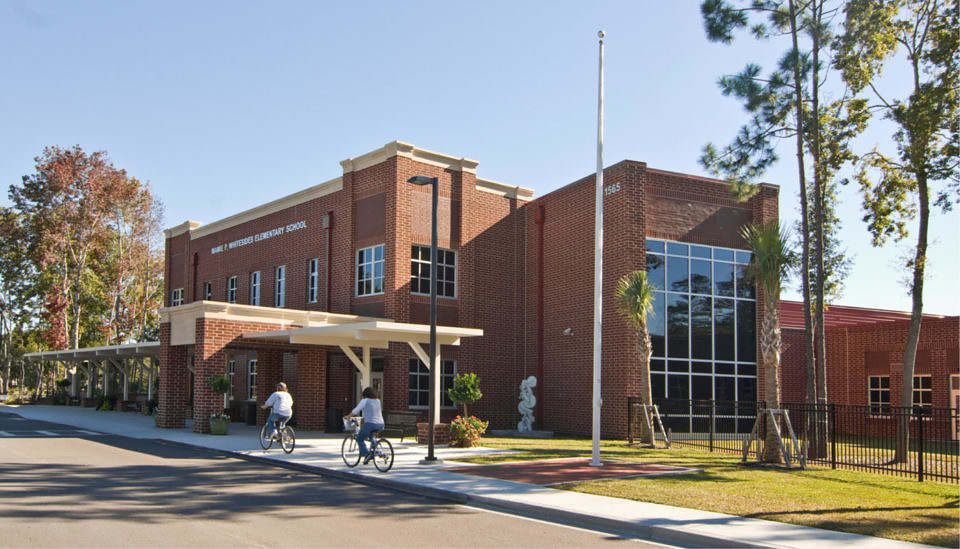|
Getting your Trinity Audio player ready...
|
Since the end of September, emergency medical services were summoned twice to Mamie P. Whitesides Elementary School in Charleston County, South Carolina to attend to small children who could not be awakened from their naps. These incidents occurred weeks apart – on September 29 and October 18 – sparking concern among parents.
The suspected culprit? Elevated levels of carbon dioxide due to poor ventilation.
While it is not known how many students at the school were impacted by poor air quality, parents have reported several cases of ongoing illnesses of undetermined origin. Meanwhile, teachers at the school documented problems with students falling asleep in class via notes sent home to parents – apparently unaware of the elevated concentrations of carbon dioxide impacting their children.
The school called for two e-learning days last week “out of an abundance of caution,” according to an email from school principal Michelle Conner addressing the issue. That email insisted the air quality at the school was “well within” standards promulgated by the U.S. Occupational Safety and Health Administration (OSHA), but acknowledged carbon dioxide levels were “higher than what is typically seen in indoor settings.”
Here was Connor’s email:
Due to concerns that were brought to me, our facilities team conducted air quality tests in our building. On Wednesday, October 11, and Friday, October 13, Facilities Management’s Environmental Services Industrial Hygienist collected carbon dioxide (CO2) readings at various locations in the building. The readings are well within OSHA standards for safe indoor air quality, but in some locations are higher than what is typically seen in indoor settings.
On Monday morning, October 16, an inspection of the HVAC system showed that the units that introduce outside air into the building were not performing at 100 percent capacity which can allow CO2 levels to stay higher. Again, although the levels are above what is seen in similar environments they are well below the level that is considered unhealthy indoor air quality. In the meantime, repairs have already been done on the outdoor air units and parts have been ordered to get them all functioning at maximum capacity as soon as possible. As an additional precaution, Facilities Management will be installing permanent CO2 monitoring devices throughout the school.
Regarding further addressing indoor air concerns, the district collected air samples in several classrooms to determine levels of indoor airborne spores. Analysis of the lab results will be received in the next week.
We will keep you updated as we receive more information, but please know that we are committed to ensuring that our building is a safe environment for all of our students and staff.
Contrary to the message provided to parents, though, sampling data indicated significantly elevated carbon dioxide concentration in samples taken between October 11-13, 2023. The data was provided by the school. The sampling (pdf) was performed by Terracon.
The elevated levels were within – and often exceeded – the range at which symptoms begin to present, according to the American Society of Heating and Air-Conditioning Engineers (ASHRAE). According to the district’s director of communications, Andy Pruitt, the district follows ASHRAE guidance for recommended carbon dioxide levels.

***
ASHRAE recommends indoor carbon dioxide levels not exceed 800 parts per million to reduce the risk of exposure-related problems – and to hinder the spread of viruses.
All of the readings taken between October 11-13 exceeded recommended levels.
“When exposed, many children start to experience chronic respiratory problems, asthma, fatigue, lack of focus, and become more susceptible to airborne viruses,” according to ASHRAE.
When concentrations of carbon dioxide are elevated to symptom-causing levels, individuals may sense that the air is foul – or smell something akin to an undesirable body odor. These are early warning signs.
The recent sampling data indicated that only one of 274 samples taken measured below 1000 parts per million – the level at which many people start to feel symptoms like sleepiness. Twenty-one samples – or less than ten percent of the total readings – fell below 1100 parts per million. Conversely, fifty-eight samples — or more than twenty percent of the group exceeded concentrations of 2000 parts per million – potentially causing such symptoms as headaches, fatigue, stuffiness, poor concentration, loss of focus, increased heart rate, and nausea, according to ASHRAE.
(Click to view)
(Via: Terracon)
THE FIX …
Repairs on the school’s HVAC system to improve air flow were completed on October 19, 2023, and subsequent sampling indicated significant reductions in carbon dioxide levels. Post-repair sampling ranged from 400–500 parts per million – well below levels expected to cause symptoms or health effects.
According to OSHA and ASHRAE, the answer to reducing carbon dioxide is often as simple as increasing air flow – opening doors and running fans. However, in a world where schools have to be concerned about shooters, it is not always possible to leave doors open.
“Additional hours of continuous airflow are in place now however for safety reasons classroom doors must remain closed during instruction but are open at various times throughout the day,” Pruitt said.
Some parents say their students have symptoms that have gone on for weeks – making them wonder how long the indoor air quality has been problematic.
An indoor air analysis performed by Terracon in January and February of this year measured indoor carbon dioxide air concentrations ranging from 600–800 parts per million –within acceptable limits. At that time, environmental analysts noted there was a “sufficient amount of outside air being introduced for the sample load at the time of sample collection.”
In addition to its HVAC repairs, the school has implemented a plan for ongoing monitoring of carbon dioxide and mold. Carbon dioxide levels will be collected weekly and sampling for mold will be conducted twice monthly.
***
FULL REPORT …
(Via: Terracon)
***
ABOUT THE AUTHOR…
Callie Lyons is a relentless investigative journalist, researcher, and author known for exposing hard truths with heart and precision. As a journalist for FITSNews, she dives into high-profile and murky cases—like that of Mica Francis Miller— with fearless resolve and a sharp eye for detail, whether it’s tracking white-collar crime, uncovering religious abuse, or examining the often-bizarre behavior of those who believe they’re above the law.
Callie made waves with her groundbreaking 2007 book Stain-Resistant, Nonstick, Waterproof and Lethal, the first to reveal the dangers of forever chemicals, a story that helped inspire the film Dark Waters and influenced global scientific dialogue. Her work has appeared in numerous documentaries, including Toxic Soup, National Geographic’s Parched: Toxic Waters, and more recently Citizen Sleuth, which examines the complexities of true crime podcasting.
Whether she’s navigating environmental disasters or the darker corners of society, Lyons operates with one guiding belief: “Truth never damages a cause that is just.”
***
WANNA SOUND OFF?
Got something you’d like to say in response to one of our articles? Or an issue you’d like to address proactively? We have an open microphone policy! Submit your letter to the editor (or guest column) via email HERE. Got a tip for a story? CLICK HERE. Got a technical question or a glitch to report? CLICK HERE.




3 comments
The charts are labeled as carbon monoxide and the issue is carbon dioxide.
Good catch on the CO2 vs CO labeling.
Well, if OSHA says the levels are safe…WHAT???? Little kids are in danger! Good grief-Fix the problem!